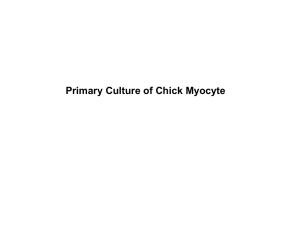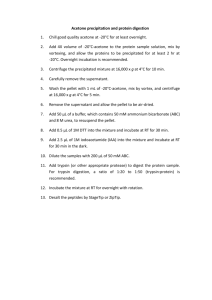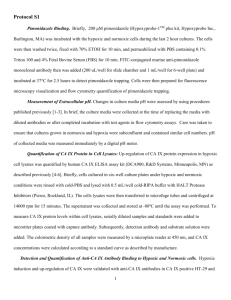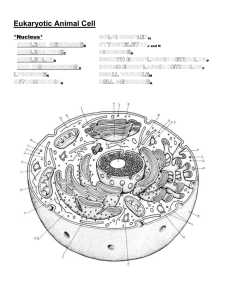pmic7401-sup-0001-suppmat
advertisement
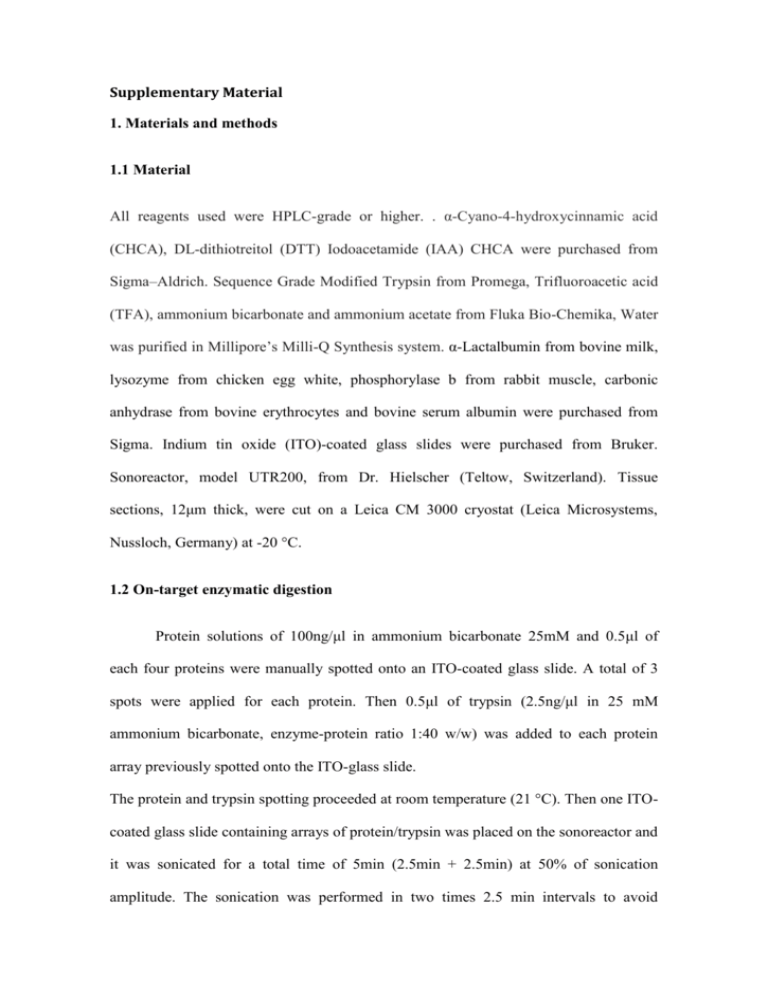
Supplementary Material 1. Materials and methods 1.1 Material All reagents used were HPLC-grade or higher. . α-Cyano-4-hydroxycinnamic acid (CHCA), DL-dithiotreitol (DTT) Iodoacetamide (IAA) CHCA were purchased from Sigma–Aldrich. Sequence Grade Modified Trypsin from Promega, Trifluoroacetic acid (TFA), ammonium bicarbonate and ammonium acetate from Fluka Bio-Chemika, Water was purified in Millipore’s Milli-Q Synthesis system. α-Lactalbumin from bovine milk, lysozyme from chicken egg white, phosphorylase b from rabbit muscle, carbonic anhydrase from bovine erythrocytes and bovine serum albumin were purchased from Sigma. Indium tin oxide (ITO)-coated glass slides were purchased from Bruker. Sonoreactor, model UTR200, from Dr. Hielscher (Teltow, Switzerland). Tissue sections, 12μm thick, were cut on a Leica CM 3000 cryostat (Leica Microsystems, Nussloch, Germany) at -20 °C. 1.2 On-target enzymatic digestion Protein solutions of 100ng/μl in ammonium bicarbonate 25mM and 0.5μl of each four proteins were manually spotted onto an ITO-coated glass slide. A total of 3 spots were applied for each protein. Then 0.5μl of trypsin (2.5ng/μl in 25 mM ammonium bicarbonate, enzyme-protein ratio 1:40 w/w) was added to each protein array previously spotted onto the ITO-glass slide. The protein and trypsin spotting proceeded at room temperature (21 °C). Then one ITOcoated glass slide containing arrays of protein/trypsin was placed on the sonoreactor and it was sonicated for a total time of 5min (2.5min + 2.5min) at 50% of sonication amplitude. The sonication was performed in two times 2.5 min intervals to avoid heating of the water in the sonoreactor. Following ultrasonic on-target digestion, 0.5μl of MALDI matrix (CHCA 10 mg/ml in 1:1 acetonitrile/0.5% TFA) was spotted directly onto the array of tryptic spots and allowed to dry. In order to assess the effects of ultrasonication to speed on-target protein digestion the following control experiments were also done: 5 min without ultrasonication; 5 min at 37ºC and 3 h at 37ºC. To the protein solution add DTT to a final concentration of 10 mM, incubate at 37ºC for 60 min, and then alkylation is done with iodoacetamide to a final concentration of 50 mM followed by 45 min incubation at RT in the dark. For tissue preparation Livers from adult Mus musculus were dissected and stored at -80 °C until analysis. Thin (12μm) tissue sections were prepared and thaw mounted onto a conductive, transparent glass slides (75x25mm) coated with an indium tin oxide (ITO) layer (Bruker Daltonics, Bremen, Germany) and frozen on dry-ice and stored at -80 °C. Tissue sections were dried and equilibrated at room temperature during 2h in a desiccator followed by a series of ethanol/water washes. The glass slide was dipped in 25 mL of ethanol/water (70:30% v/v) and gently agitated for 30s followed by a 30s wash in ethanol (25 mL). Excess solvent was removed by a gentle flow N2 gas. A solution containing 125ng/μl of trypsin in 12.5mM of ammonium bicarbonate was manually spotted onto the liver sections by pipette deposition to obtain 40ng of trypsin/mm2. Two depositions of 500nL were used. Each spot appeared to dry completely between each successive spotting. The trypsin spotting proceeded at room temperature (21 °C). After trypsin application the sample was placed in a humidified chamber at 37ºC and digested for 3h or was accelerated by means of ultrasounds. 1.3 Mass spectrometry analysis All mass spectrometry analysis was performed using an Ultraflex II MALDITOF/TOF instrument from Bruker Daltonics equipped with a 200 Hz Smartbeam laser system. Data was acquired using FlexControl 3.0 (Bruker Daltonics). Close external calibration was performed with the monoisotopic peaks of the Bradykinin 1-7 (757.3992), Angiotensin II (1046.5418), Angiotensin I (1296.6848), Substance P (1347.7345), Bombesin (1619.8223), renin substrate (1758.9326), ACTH clip 1-17 (2093.0862), ACTH 18-39 (2465.1983), Somatostatin 28 (3147.4710). The mass spectrometer was operated with positive polarity in reflectron mode and spectra were acquired in the range of m/z 1000-4000.A total of 3000 spectra were acquired at each spot position at a constant power and at a laser frequency of 100 Hz. MALDI tandem mass spectra experiments were performed in laser induced dissociation (LID) mode using an Ultraflex II LIFT TOF/ TOF mass spectrometer. Fragments derived from metastable peptide ions generated by LID and accelerated at 8 kV were selected in the timed ion selector (TOF1), post-accelerated at 19 kV in the LIFT cell and detected after separation (TOF2). Peak lists and spectral processing were done in FlexAnalysis 3.0 (Bruker Daltonics). For generation of the peak lists from the mass spectra the SNAP algorithm was used For protein identification MASCOT version 2.2 (Matrix Science, London, UK) was used and the following parameters were used: database (SwissProt, version and number of sequences); taxonomy (All entries); proteolytic enzyme (Trypsin); peptide mass tolerance (±50 ppm); fragment mass tolerance (±0.5 Da); variable modification (Oxidation (M)); peptide charge state (1+) and missed cleavages allowed (1). The significance threshold was set to a minimum of 95% (p≤0.05). A match was considered successful when the protein identification score is located out of the random region and the protein analyzed scores first. The tissue profiles were acquired using an Ultraflex II MALDI-TOF TOF instrument (Bruker-Daltonics Billerica, MA) equipped with a LIFT cell and Smartbeam laser. For peptides, the mass spectrometer was operated with positive polarity in reflectron mode and spectra were acquired in the range of m/z 1000-4000. A total of 3000 spectra were acquired at each spot position at a laser frequency of 100 Hz. Table 1SM. Mascot score, protein sequence coverage and number of identified peptides obtained after PFM analysis of single protein digests (3h digestion at 37ºC and 5 min ultrasonic digestion at 50% ultrasonic amplitude). Three replicates were done for each experimental condition. Mascot % Sequence No. Identified Mascot % Sequence No. Identified 5min digestion at 37ºC Mascot Score a Coverage peptides Score a coverage peptides Score a Score a 80±6 29±1 8±1 75±5 28±1 7±1 48 50 90±9 43±3 7±1 154±15 61±5 11±1 30 48 185±14 68±1 19±2 115±8 60±3 15±3 60 46 234±5 37±2 29±1 115±10 26±5 14±3 58 34 214±4 41±5 35±3 244±22 42±5 33±4 61 60 3h digestion at 37ºC Alpha-lactalbumin Bos taurus Lysozyme C Gallus gallus Carbonic anhydrase Bos taurus Serum albumin Bos taurus Glycogen phosphorylase Oryctolagus cuniculus a Ultrasonic digestion 5min, 50% Protein scores greater than 70 are significant (p<0.05). 5min without ultrasonication Mascot 1 2 3 4 5 6 7 Fig. 1SM. MALDI spectra of 50ng of protein digested on ITO-coated glass slide (0.5μl of solution containing 2.5ng/μl of trypsin in 25mM ammonium bicarbonate). Panels A, E, I and M– α-lactalbumin; B, F, J, N– lyzozyme; C, G, K and O– carbonic anhydrase; D, H, L and P– serum albumin. Panels A-D proteins were digested in 5 min with sonoreactor (2.5 + 2.5min) at 50% of sonication amplitude. Panels E-H proteins were digested in 5 min without ultrasonication. Panels I-L proteins were digested in humidified chamber for 3h at 37ºC. Panels M-P proteins were digested in humidified chamber for 5min at 37ºC. 8 9 10 11 12 13 Fig. 2SM. MALDI spectra of 50ng of protein digested on ITO-coated glass slide (0.5μl of solution containing 2.5ng/μl of trypsin in 25mM ammonium bicarbonate). Panel A– α-lactalbumin; B– carbonic anhydrase; C– Lyzozyme; D– phosphorylase b. Proteins were digested 5min without the use of ultrasonication. 14 15 16 17 18 Fig. 3SM. MALDI spectra of 50ng of protein spotted on ITO-coated glass slide (without the aid of trypsin) and sonicated for 5 min with sonoreactor (2.5 + 2.5min). Panels A– α-lactalbumin; B– carbonic anhydrase; C– Lyzozyme; D– phosphorylase b. 19 20 21 22 Table 2SM. Proteins identified in each protein mixture by tandem mass spectrometry after 5 min of ultrasonication with 50% ultrasonic amplitude. Three replicates were done for each experimental condition. Protein (Swiss-Prot) LALBA_BOVIN CAH2_BOVIN Amount of [M+H]+ Peptide sequence protein (ng) m/z 8 1200.7 VGINYWLAHK 15 Mix 1 LYSC_CHICK 8 2198.2 AVVQDPALKPLALVYGEATSR 69±7 1428.7 FESNFNTQATNR 91±11 1675.8 IVSDGNGMNAWVAWR 48±3 1753.8 NTDGSTDYGILQINSR 152±8 PYGM_RABIT 50 1566.8 DFNVGGYIQAVLDR 45±2 LALBA_BOVIN 8 1200.7 VGINYWLAHK 31±1 CAH2_BOVIN 7.5 1018.5 DFPIANGER 22±6 2198.2 AVVQDPALKPLALVYGEATSR 51±3 LYSC_CHICK 8 1428.7 FESNFNTQATNR 81±2 1753.8 NTDGSTDYGILQINSR 83±3 PYGM_RABIT 25 1566.8 DFNVGGYIQAVLDR 25±6 LALBA_BOVIN 4 - Mix 2 Mix 3 Ion score 74±3 CAH2_BOVIN 15 LYSC_CHICK 4 PYGM_RABIT 50 - - 1018.5 DFPIANGER 22±5 1141.5 HNGPEHWHK 43±3 2198.2 AVVQDPALKPLALVYGEATSR 94±16 1428.7 FESNFNTQATNR 73±4 1753.8 NTDGSTDYGILQINSR 81±1 1566.8 DFNVGGYIQAVLDR 45±1 23 24 25 26 27 Fig. 4SM. MALDI spectra of 50ng of protein spotted on ITO-coated glass slide. Proteins were on-targe reduced, on-target alkylated and digested for 5 min (2.5 + 2.5min) with sonoreactor at 50% of sonication amplitude. Panel A– α-lactalbumin and B– carbonic anhydrase. 28 29 30 31 32 33 34 35 Fig. 5SM. MALDI spectra of mixtures of protein digested on ITO-coated glass slide (0.5μl of solution containing 2.5ng/μl of trypsin in 25mM ammonium bicarbonate). Panels A and D– α-lactalbumin (8ng), carbonic anhydrase (15ng), lyzozyme (8ng) and phosphorylase b (50ng); B and E– α-lactalbumin (8ng), carbonic anhydrase (7.5ng), lyzozyme (8ng) and phosphorylase b (25ng); C and F α-lactalbumin (4ng), carbonic anhydrase (15ng), lyzozyme (4ng) and phosphorylase b (50ng). Panels A, B and C protein mixtures were digested for 5 min (2.5 + 2.5min) with sonoreactor at 50% of sonication amplitude. Panels D, E and F were digested in humidified chamber for 3h at 37ºC. 36 37 38 39 40 41 42 43 Fig. 6SM. MALDI spectra of mixtures of protein digested on ITO-coated glass slide (0.5μl of solution containing 2.5ng/μl of trypsin in 25mM ammonium bicarbonate). Mix I– α-lactalbumin (8 ng), carbonic anhydrase (15 ng), lysozyme (8 ng) and serum albumin (25 ng); Mix II– α-lactalbumin (8 ng), carbonic anhydrase (7.5 ng), lysozyme (8 ng) and serum albumin (12.5 ng); Mix III– α-lactalbumin (4 ng), carbonic anhydrase (15 ng), lysozyme (4 ng) and serum albumin (25 ng). Panels A to C– samples were digested in 5 min with sonoreactor (2.5 + 2.5min) at 50% of sonication amplitude. Panels D to F proteins were digested in humidified chamber for 3h at 37ºC. Panels G to I proteins were digested in 5 min without ultrasonication. Panels J to L proteins were digested in humidified chamber for 5 min at 37ºC.

